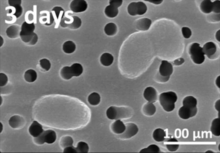| Vibrio harveyi | |
|---|---|

| |
| Scientific classification | |
| Domain: | Bacteria |
| Phylum: | Pseudomonadota |
| Class: | Gammaproteobacteria |
| Order: | Vibrionales |
| Family: | Vibrionaceae |
| Genus: | Vibrio |
| Species: | V. harveyi
|
| Binomial name | |
| Vibrio harveyi Johnson and Shunk 1936
Baumann et al. 1981 | |
| Synonyms | |
|
Beneckea harveyi (Johnson and Shunk 1936) Reichelt and Baumann 1973 | |
Vibrio harveyi is a Gram-negative, bioluminescent, marine bacterium in the genus Vibrio. V. harveyi is rod-shaped, motile (via polar flagella), facultatively anaerobic, halophilic, and competent for both fermentative and respiratory metabolism. It does not grow below 4 °C ( optimum growth: 30° to 35 °C). V. harveyi can be found free-swimming in tropical marine waters, commensally in the gut microflora of marine animals, and as both a primary and opportunistic pathogen of marine animals, including Gorgonian corals, oysters, prawns, lobsters, the common snook, barramundi, turbot, milkfish, and seahorses.[1] It is responsible for luminous vibriosis, a disease that affects commercially farmed penaeid prawns.[2] Additionally, based on samples taken by ocean-going ships, V. harveyi is thought to be the cause of the milky seas effect, in which, during the night, a uniform blue glow is emitted from the seawater. Some glows can cover nearly 6,000 sq mi (16,000 km2).
- ^ Owens, Leigh; Busico-Salcedo, Nancy (2006). "Vibrio harveyi: Pretty Problems in Paradise (Chapter 19)". In Thompson, Fabiano; Austin, Brian; Swings, Jean (eds.). The Biology of Vibrios. ASM Press.
- ^ Austin B, Zhang XH (2006). "Vibrio harveyi: a significant pathogen of marine vertebrates and invertebrates". Letters in Applied Microbiology. 43 (2): 119–214. doi:10.1111/j.1472-765X.2006.01989.x. PMID 16869892.